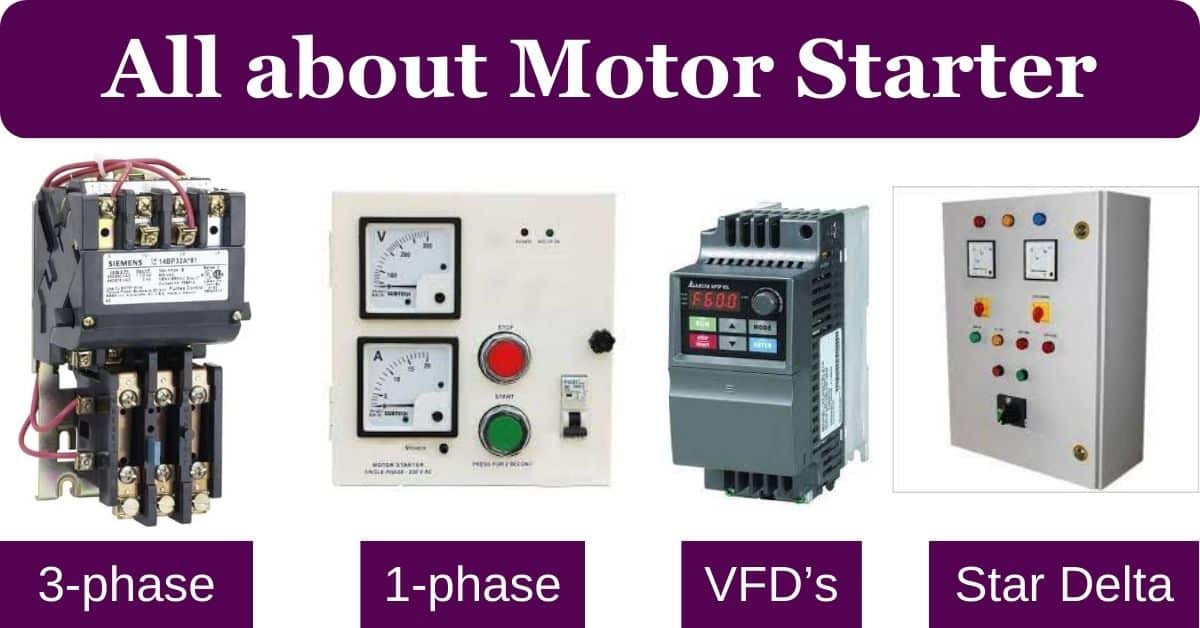A Motor Starter is like a switch for electric motors. It helps them to start up the motor smoothly and turns off them without any jerk. Thinks of it a helpful tool that makes sure our motor runs just right without any problems.
in our previous tutorial we have already discuss All about DC motor controller and what is electric motor– its working principle, motor types, application and many more. so in this tutorial our agenda is to understand what is motor starter- its working principle, types application etc. so lets begin
Definition of Motor Starters
A Motor Starter is a device that are used to control the starting and stopping of electric motors. A motor starter made up of various parts like as switches and relays that all parts put together into one unit.
The primary role of motor starters is to protect the motor from getting damaged by things like too much voltage or overheating etc.
Block diagram of motor starter
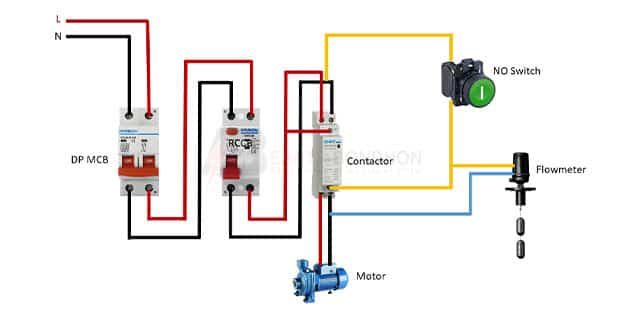
How motor starters work
Motor starter are important devices used to control electric motors. To start a motor, we must turn on the motor starter so this closes its (closed circuit) switches that allowing electricity to reach the motor. As a result, the motor starts spinning and carrying out its tasks.
Inside the motor starter there is an overload relays are placed so these relays keep an eye on the electric current going to the motor.
If the current goes too high and could damages the motor, these relays stop the flow of electricity by opening the circuit.
When we want to stop the motor, we have to switch off the motor starter. This opens the switches (open circuit) in the starter, hence stopping the flow of electricity to the motor and causing it to stop spinning.
Work flow diagram of 3-phase motor
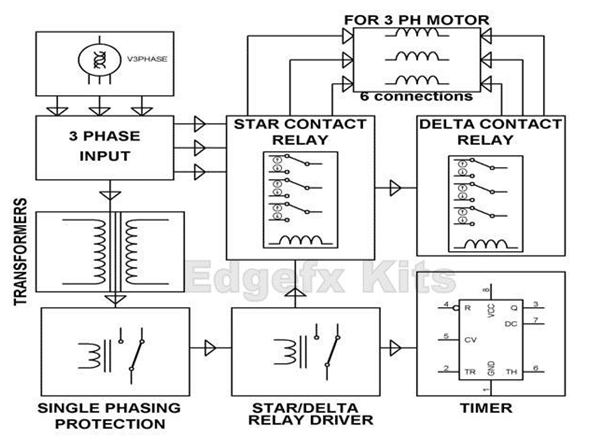
Working Principle of Motor Starter
Although we have covered working of motor starter so now go deeper into what exactly principle of the motor starters and how actually it works so let us begin –
The key components of motor starters are
Contactor
Overload relays
Control circuit
So, lets discuss one by one in brief manner
Contractor:
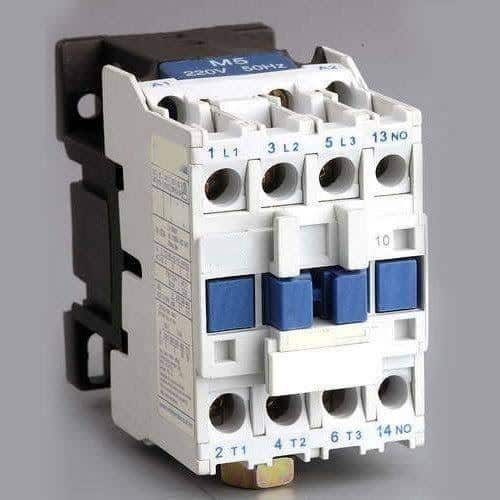
A contactor is an electronically controlled switch that acts as the gatekeeper for current which flows to the motor.
When contractor get energized its coil trigger a magnetic field that closing the contractor contacts and allowing current to pass through.
Conversely when de-energizing the coil opens the contacts and hence stopping the motor.
Overload relay:
Working of Overload relay in motor starter
The overload relay serves a crucial function in protection electric motors from damages due to excessive current.
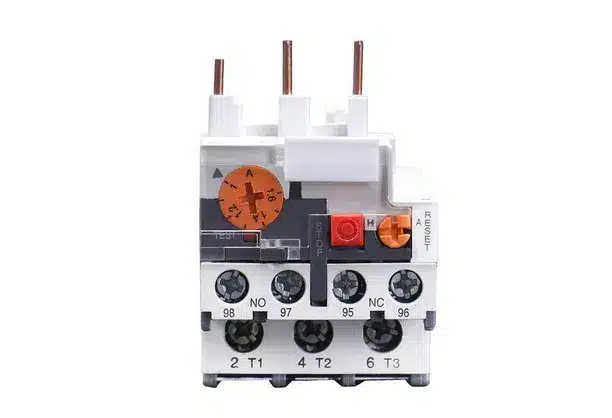
Here’s how it works –
This overload relay is connected in series with motor power supply for sensing how much current passes to the motor. It contains current-sensing mechanism it is typically a bimetallic strip or a current transformer which monitors the amount of current flowing through the motor.
The relay is set to specific limit which represents the maximum safe current for the motor under normal conditions.
During regular operation if the motor’s current stay below the limit, then relay stay inactive but whenever the current goes above the limit it considers as overload then relay kicks into action.
After that it responds by opening a set of contacts inside which stops the flow of current to the motor.
This action effectively cuts off power to the motor hence it prevents further damages by protection some important parts like as windings if we do not use overload relays then these windings get hot and eventually burn and make more costly to repair.
Control circuit:
A control circuit receives input from buttons this circuit provides overload protection and ensure safety through interlocks.
They are crucial for controlling motors in a wide range of applications from industrial machinery to household appliances.
Analog Vs digital motor starter
| Feature | Analog Motor Starter | Digital Motor Starter |
|---|---|---|
| Control mechanism | Relies on analog components | Utilizes digital electronics |
| Precision and accuracy | Limited precision and accuracy | Higher precision and accuracy |
| Easy to use | Simple setup with physical controls | User-Friendly interfaces for programming |
| Reliable and Maintenance | Susceptible to wear and tear | Generally more reliable with fewer moving parts |
| cost | Cheaper upfront cost | More expensive initially, potential long-term cost savings |
Different techniques used in Motor Starters
In industrial operation mostly uses single phase and three phase induction types motors because they are more efficient than other types of motors. For three-phase induction motor there are mainly three different techniques are applicable. So, let us discuss one by one
Full voltage technique
The full voltage technique or direct On-line (DOL) starting is a typically used for small induction motors or applications where the starting conditions are manageable in terms of current and torque requirements.
This DOL technique is applied for such motor which has rated less than 5HP.
There is another method in DOL –
Reduced voltage technique:
The reduces voltage technique is a strategic approach used in motor starting to lessen the negative effects caused by high initial currents and mechanical stresses that will occur during DOL starting.
It has a simple mechanism initially reduce the motor voltage for few seconds until the motor rotate after that increase the applied voltage so the rotation speed of the motor also increases.
This method is suitable for larger motors rated in the range of 100HP and above it.
Bidirectional starter technique
The Bidirectional starter methods is applicable when motor need to operate in forward and reverse directions. This method particularly suitable in applications where the motor needs to change its direction frequently or perform reverse tasks.
Multispeed technique
This multispeed technique give scope to operate at different speed by varying the frequency of the power supplied to it.
This method is commonly used in application where multiple speed is required, speed is depending on starter design generally operate the motor at two or three different speeds with two more contactors.
Types of motor starters

Based on the above techniques, here are the types of motor starter, so lets discuss
DOL (Direct On-Line Starter)
In direct On-line starter we can directly connect motor to the power supply so there is no need to reduce the voltage.
This starter is type of electromechanical starter that used to start three-phase induction motor. It is one of the simplest and most common methods of motor starter. DOL starters are suitable for small motors.
Star delta starter
In Star Delta starter during induction motor start it run on star after motor get some speed then it converts into Delta at rated speed. Here TPDT (triple pole double throw) switch are used this switch start to delta because of this conversion applied voltage to the motor is reduced by the factor of 1/3.
VFD’s (Variable Frequency Drive)
VFD’s are use for AC motor to control speed via adjusting input frequency because these motor’s speed is directly proportional to power supply.
A variable frequency drive (VFD) is an electronic device that used to control the speed and torque of an electric motor by varying the frequency and voltage of the power supplied to it.
Also, VFD’s can adjust the voltage and maintain the magnetic flux for proper operation with ensuring efficient and consistent performance across the speed range.
Variable frequency drive gives smooth acceleration and deaccelerations to the motor by eliminating sudden jerk to the equipment’s.
Some other advantages like as: – energy saving, adjust speed according to the load overall reduces energy consumption compared with other starters.
Auto transformer starter
An auto transformer is a type of transformer which has only one winding, this winding id tapped in different points to achieve the desired voltage transformation.
Our traditional transformers have separate primary and secondary windings but an auto transformer uses a single winding for both (input as well as output).
This transformer uses for starting purpose of motor.
Soft starter
Soft Starter is a type of motor starter used to control the starting current and speed of electric motor especially those with high starting torque requirements.
It works by limiting the voltage applied to the motor which results reduces the starting current and prevents excessive stress on the motor windings.
Soft starter also offers other advantages such as improved efficiency, reduced power demands and enhances control over speed and acceleration.
How to choose suitable motor starter
So, one question come in mind that how we can choose a particular motor starter and what are the criteria
- Check the motor specs: note voltage, current, horsepower and phase of the motor.
- Application needs: consider torque, duty cycle and environment
- Enclosure protection: ensure adequate safeguarding
- Control options: decide either manual or automatic
- Future expansion: choose scalable options.
- Consult experts: give guidelines from expert if you are unsure.
These steps will help to select right motor starter for your needs.
Importance of motor starters
- Prevent motor damage during startup
- Protect against overloads and failure
- Enhance safety
- Enable remote control and automation
- Aid troubleshooting and maintenance
- Improve system reliability
Advantages of motor starters
- Overvoltage protection
- Soft start / stop
- Reduced wear and tear
- Integrated with control system
- Customized options
Disadvantages of motor starters
- Initial cost can be high.
- Using motor starter will increase complexity of installation.
- Required additional space for installation.
- May not suitable for all applications.
- Limited flexibility for future upgrade or modification.
- Some types of starters may produce audible noise during operation.
Applications of motor starters
- Industrial machinery
- HVAC systems
- Mining equipment’s
- Oil and gas industry
- Automotive manufacturing
- Agricultural machinery
More Tutorials:
DC motor controller – working principle, definition, types
Conclusion
In summary, motor starter is essential for managing and safeguarding electric motor against potential damage from overload, short circuit and other electrical issues.
They give smooth starting and shopping operation, also ensure the efficiency of motor. A wide range of applications and types are available in market. As technology get advanced motor starters continuously improves and offers more features for enhancing performance and safety.
References
